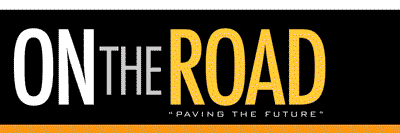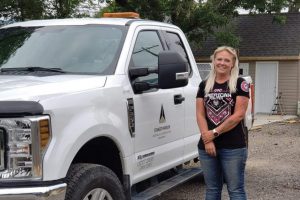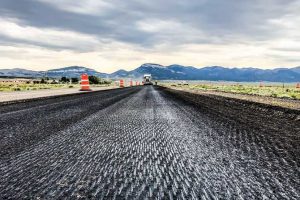How did you get involved in civil engineering?
My dad was a civil engineer, but I didn’t know what that meant when I was growing up. There is a technical school close to our home. I took mechanical drafting there during high school and liked it. My older brother was a Civil Engineering student. He knew I liked drafting, encouraged me to take some engineering classes at Utah State University, and I ended up getting my degree in civil engineering.
How long have you been involved with the Utah Section of ASCE?
I was a member of the student chapter in college. After graduation in 1998, I didn’t register as a full member until around 2005. In 2011-2012, I became more involved in giving back to the community as part of the Community Giving Committee. I continued to serve in various capacities and was on the Wasatch Front Board, served as the Utah Section President, and then became the committee chair for the infrastructure report card.
Had you worked on the infrastructure report card previously?
This report card is only Utah’s second one, and it was the first one I’ve worked on. The first report card was in 2015. Several members who worked on the 2015 report card helped me with the 2020 report card.
Why does infrastructure affect the state’s ability to be competitive?
As our state continues to grow, our population is going to continue to grow. We need to have quality infrastructure in place. Good infrastructure plays an important role in the sustainability of our state’s growth. If we invest in resilient and sustainable infrastructure, the infrastructure it helps us build stronger, healthier, and more prosperous communities. We will have a higher quality of life if we improve the places we live, work, and play.
What would you say to those who are pushing back on the need to invest in infrastructure?
Communities supported by integrated mobility and updated utilities that sustain health and economy, will elevate the overall quality of life.
How did engineers decide on the grades that were given (federally and by state)?
There’s an established process for doing these report cards. We assemble a team of engineers who are members of ASCE, and we create our committee. We, define the categories we want to evaluate, study existing literature and news reports, and interview agency representatives. For example, for the drinking water section, engineers interviewed leaders and staff at the water conservancy districts, reviewed master plans on the state and local level, and examined state and city budgets to get an idea of funding. Then we take the information we researched and evaluate it against eight criteria:
- Capacity
- Condition
- Funding
- Future need
- Operation and maintenance
- Public safety
- Resilience
- Innovation
Depending on how each category meets the criteria, engineers use the results to establish the grade. The grading process is the same on the national level but with national organizations.
The overall grade for the U.S. was a C-. The Utah grade was a C+. Why is Utah’s grade slightly better than the one for the nation as a whole?
There are a variety of reasons. The main one is that our top grades were given to roadways, bridges, and transit. All three got a B+. We have a quality transportation system that we do really well.
On the national report card, roadways got a D, bridges got a C and transit was a D-.
Even though Utah’s grade was better than the overall grade, getting a C grade is not terrific. How worried should people in Utah be about that? How does it compare to previous grades?
Everyone should be concerned about our infrastructure because it affects everyday life. Infrastructure that is resilient and sustainable has a direct correlation to our quality of life. As a result, ASCE members are concerned about the consequences if we fail to invest adequately. We estimate that over the next 20 years, failing to invest will cost individual households $3,300 a year. That number comes from purchases individual households will have to make, such as the wear and tear on cars from potholes, dirty tap water that causes people to buy water from the store, and poor health care access. There are lots of little things that can make life more expensive in general.
What are the bottom three grades? Why?
Canals were a D+, levees were a D- and dams were a C+.
Given that Utah is currently experiencing serious drought conditions, how important is it to put money into the state’s levees?
I spoke with the author of the levee section about that, and he said Utah is exposed to periods of extreme precipitation and drought. Our experience has been that periods of drought are often followed by increased moisture, which can cause flooding. Future climate change can add new events, but the risk and associated costs of flooding will only continue to escalate.
Since we know we have high cyclical drought and runoffs, investing now would be good. Although we are already preventing flooding, we have over 100 miles of levees that were not constructed according to modern standards. The levees were built to protect farmland. Now the land has been developed, and broken levees would cause more damage than they would have in the past. It would affect 125,000 Utahns and cost $10 billion in property damage.
You worked on the report section about roads. Replacing gas tax revenue is important; how do you think that issue is going to play out? How have owners of electric and hybrid vehicles responded so far to the idea of paying an annual flat fee or a usage-based fee?
ASCE strongly advocates for a gas tax. We still think the gas tax is the best short-term solution. It provides a way for everyone to pay their fair share of our transportation system.
Although we still need to find a long-term solution, we suggest a three-pronged approach for providing future funding:
- Increase the gas tax for the next five years.
- Start taxing electric vehicles.
- Put more research into the miles traveled pilot. We need to know if it is working and find a sustainable model for the future.
I haven’t seen responses from car owners, and I haven’t seen anything about a public response, either. A program with a road-use charge went into effect a year ago. People were asked to enroll voluntarily. They could pay a flat fee upfront or pay the fee as they typically do.
At a UDOT conference in 2019, there was a session where the new program was presented. I don’t know how many people enrolled, but I’ve spoken to a couple of colleagues who work at gas refineries. They are working on planning and transportation in and out of the refineries. The refineries are working as close to capacity as they ever will. Gasoline demand will go down in the future, and refineries are expected to produce less and less gas.
According to the report, Utah’s municipal solid waste recycling is 1.45%, versus a national recycling ratio of more than 35%. Would you please put these percentages in context?
The 1.45% is the total tonnage that is diverted to recycling. We have very limited data beyond aggregate tonnage, so we wrote the report in comparative terms, but the number we did get for Utah was based on recent reports. We were fortunate to find a report about recycling from a company called Eunomia International Environmental Consultants (https://www.eunomia.co.uk/).
After we gathered the information for the report card, the Eunomia report developed a new methodology for measuring recycling rates. In Utah, the rate under the new methodology improved to about 17%, which is comparable with other western states. Although higher rates would be better, 17% is consistent with policy trends and common markets in our region.
President Biden’s focus on infrastructure has also brought infrastructure to people’s attention, and we have piggybacked on that. We are using the national platform to advocate for adequately investing in our infrastructure.
Are we still sending our recycling materials to China?
China and other countries have increased restrictions or banned materials for recycling. Those policies culminated in an import ban at the end of 2020 on waste materials. As a result of the ban, we don’t send much to China anymore.
International restrictions based on the types of recycled materials do affect the U.S. recycling market in several ways. For example, operating and handling costs for recycling handlers have increased.
Are there plans to increase the number of recycling stations in Utah?
In 2020, Utah did build a new $17 million recovery center for waste management.
The Eunomia report I mentioned earlier said that other states have increased recycling efforts. Their efforts include creating strong curbside programs and paying people to return beverage containers. We could do the same things here, but one issue we have is that Utah has only used 5% of its landfill area. We have less of an incentive to commit to recycling than places that are running out of landfills. Dumping is not sustainable, but it’s difficult to help people understand the value of recycling since space is not an issue.
In some parts of Salt Lake County, the materials that can be recycled are quite restricted. It used to be possible to recycle more things. Is that likely to change again in the near term?
I don’t know about that. A lot of it comes down to profitability. Some things are recyclable, but it isn’t profitable, or the cost is significantly more than the revenue. Recycling those items is not feasible right now. However, expanding the recycling program would help with sustainability; the more we can recycle, the longer life we will have out of our landfills.
Some good projects are going on that make use of landfills. For example, some landfills have collection systems for methane gas. They can use the methane gas for power generation or whatever else needs to be done.
In the section about transit ridership, the report talks about high-density housing. How much of that high-density housing is affordable?
I don’t know about the affordability of the housing. Nothing is really affordable right now. As we did our report, we included recommendations, and one of them was that we increase services for a lot of the underserved population.
For those with a lower income, we recommended that those populations have fair transit service. A lot of people can save money by riding transit. Having a good transit system helps those who don’t have a car. They can get around quickly without spending the money they would have to spend to buy and maintain a car.
Is there anything you would like to say about the report that you haven’t talked about already?
This report card is only the second one, and we didn’t get as much attention in 2015 as we are getting now. We have put more effort into outreach and presentations, and we are carrying our message to elected officials. President Biden’s focus on infrastructure has also brought infrastructure to people’s attention, and we have piggybacked on that. We are using the national platform to advocate for adequately investing in our infrastructure.
We had five overarching recommendations about how to raise our infrastructure grade. Our focus was on getting the biggest possible bang for the buck.
- We suggested a statewide risk assessment framework that would prioritize and program funding for infrastructure categories with the lowest grades (levee flood control and canal projects).
- Dam rehabilitation in Utah is an issue right now; rehabilitating the high-risk dams will take 60 years on the current schedule. We want to improve the frequency from 60 years down to 25 years.
- Another area is extending the lifecycle costs of water systems by providing statewide guidelines for construction, operation and maintenance.
- We talked about recycling, but we also need to update state waste management practices. That means sustainable waste management, circular economy management and reducing the waste stream
- Our underserved communities need frequent and reliable access to transit.
I want to make one final point: Utah and Georgia got the same grade, a C+. No state earned a higher grade than that. In that sense, despite the need to improve, Utah and Georgia were the best in the nation.







